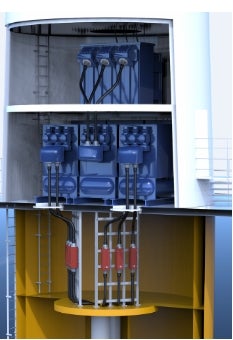
In future, wind farms will be cabled internally with 66kV instead of 33kV, according to the Offshore Wind Accelerator (OWA) support programme.
While some technologies are still under development or undergoing testing, there is a cable-independent connection system that has stood the test for this application: CONNEX.
This has been in use for more than 25 years and was recently expanded to include technology for 66kV inter-array cabling.
Increasing voltage to 66kV lowers costs and environmental impacts, and ensures higher supply security and power levels.
To promote the technical innovations required for this, the industry and the UK Department of Energy and Climate Change have initiated the OWA programme with the support of the Carbon Trust, an international organisation committed to carbon reduction, which promotes, among other things, the development of new 66kV inter-array cables.
PFISTERER CONNEX connection system product manager Christian Späth said: "Connection and connector technology used offshore for plastic cables has been influenced by onshore standards like the 33 kV outer cone systems.
"However there are not yet any systems like those available for the intended 66kV cabling, but there are some inner cone solutions instead."
CONNEX inner cone system
CONNEX has been on the market as the first inner cone system for all standard XPLE and EPR cables since 1978.
It has been used for maximum operating voltages up to 72.5kV in onshore applications since 1988. This supported the move into different offshore applications, and CONNEX is also used for transformer and switchgear (GIS) connections up to 170kV, as well as inter-array cabling for medium voltage for more than six years.
In addition to cable connections for transformers and gas insulated switchgear (GIS), the system includes surge arresters as well as dummy plugs and test cables.
Combined with the newest addition to the range, the test cables result in flexible test equipment. The new connection joint for cable interfaces up to 72.5kV was introduced in the third quarter of 2014.
Like all CONNEX connection components, it is resistant to salt water, UV rays and is submersible. If water manages to enter one of the connected cables as a result of a cable failure, the integrated longitudinal water barrier prevents penetration of the others.
DVN GL, the largest ship and offshore classification association in the world, confirms the offshore qualities of the HV-CONNEX joints.
"Efficiency and safety are inherent standards in the development and expansion of this system," Späth adds.
"That’s why all CONNEX connection components are dry pluggable, touch-proof and maintenance-free. That makes installation and operation easier."
Nexans Cable Accessories product manager Volker Aue said: "By participating in the OWA programme, we are pushing the introduction of our new 66kV inter-array cables.
"An important step in this process is standardised qualification in suitable cable connection systems. In the meantime, this has been achieved with PFISTERER.
"In April 2014 we successfully qualified one of our new cables combined with the CONNEX solid-insulated joint and the CONNEX separable connector up to 72.5kV."
Image: HV-CONNEX offers dry pluggable cable connectors for transformers and GIS, as well as pluggable joints for the 66kV voltage level. Photo: courtesy of PFISTERER.

